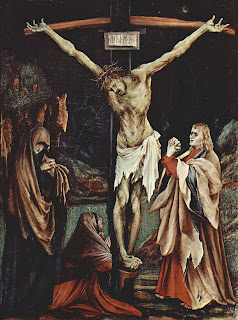My last post talked about the Feast of the Exaltation of the Cross, and its history post-Christ. But there are a lot of legends of the origin of the Cross as well. Most stories developed in the early medieval times to emphasize Christ as the New Adam and the Resurrection has the victory over the Fall.
I’ve been reading the Golden Legend lately, which includes
lots of heroic, miraculous heliographies as well as a few stories about the
Cross. The Golden Legend was compiled by the Bishop of Genoa, Jacobus de Voragine,
in 1260.
In one story, it is said that after Adam died, his son Seth planted three seeds in the mouth of Adam’s corpse. A “tree of mercy” grew from those seeds and was the tree used to make the Cross. Sometimes these seeds are said to have grown three different types of wood, one of which also grew the bush that became the burning bush.
In another story, the Cross came from part of the Tree of Knowledge of Good and Evil. As Adam was dying, he sent Seth to the gates of the Garden of Eden to beg God for an oil of mercy distilled from the Tree. Seth found the way by following the footsteps of Adam and Eve, as nothing had grown where they stepped during their expulsion. St. Michael appeared to Seth at the gate and gave him a branch from the Tree. Again, Seth planted this cutting of the tree on Adam’s grave. From this tree came Moses’ staff. David planted it in Jerusalem. Solomon had it cut down to be a beam in the Temple, but it was not found suitable, so the wood was used to build a bridge, over which the Queen of Sheba passed on her journey to meet Solomon. She recognized the importance of the wood used in the timber and fell to her knees along the bridge and revered it. She told Solomon that a piece of that wood would bring about a new covenant of God. Solomon, fearing this revelation, ordered the timber buried. Centuries later, these beams were discovered and used by the Romans to fashion the Cross on which Jesus was crucified.
Of course, these links to Adam also tie in with Calvary
being the “place of skull.” While the name could have arisen as a place of
execution or because the hill resembled a skull, some associated it as the
burial place of Adam. A legend from around the 9th century is that Adam was first
buried on Mount Ararat; after the flood Shem and Melchizadek moved his body to
Calvary, where Adam had crushed the serpent’s head following the Fall. Medieval
icons often show the skull of Adam buried right underneath the Cross. Jesus’
death and resurrection is contrasted with Adam (and Eve) bringing death into
the world.
Other traditions are that the Cross comes from Lebanese
cedar transplanted by King David just west of Jerusalem. There are churches standing
over the spots where it is claimed the tree grew.
In the Eastern tradition, the Cross was actually made from three
different types of wood: commonly cedar, pine, and cypress. This relates to Isaiah
60:13 which references three types of wood at the glory of God’s feet. These
trees grew together, were watered by Lot, and used in the construction of the
Temple. During Herod’s reconstruction, these pieces of wood were discarded,
eventually used to construct the Cross.
Other theologians posited that the Cross was made of four types of wood. The Venerable Bede recorded that the Cross was made of cypress, cedar, pine, and box. St. Innocent wrote that the upright beam was of one wood, the transverse beam of another, the title plaque of a third, and that the feet were supported on a projecting step made of a fourth wood.
Legends surrounding different trees also arose as they
became linked to the Cross. In England there was a story that the wood was
mistletoe, then a large tree, but ever since it was used in the Crucifixion of
Christ, it grew as a shrubby parasite. Other woods associated with the Cross
are aspen, olive, and oak.
Again, the legends and folktales are nearly impossible to
sort through and verify, but in most cases, they draw the line from Adam to
Jesus, showing the importance of the New Adam and the need for God’s mercy on
His fallen people. The stories of the Bible are really one continuous story,
the relationship of God and man. The Cross, the Passion of Christ, is the crux
(pun intended) of that story. It’s important to be able see its branches, figuratively
more than literally, throughout history.





No comments:
Post a Comment